Sisters' Words of Wisdom: Sister Mary White, OSB
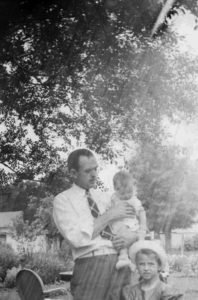
Pictured here is Sister Mary (baby) with her father and sister, Catherine, in 1942.
Sister Mary (Kathleen) White was born in Farmington, MN. She grew up in Lakeville in a household with two sisters and three brothers. Her family has owned and operated White Funeral Homes for over 100 years, which continues to this day with five locations in the Twin Cities southern metro area. Mary attended boarding school at Our Lady of Good Counsel Academy in Mankato for ninth and tenth grades and returned to Lakeville for her junior and senior years in high school.
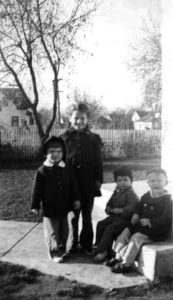
Pictured here is Mary and her siblings in 1943. Sister Mary and her two sisters and three brothers grew up in Lakeville, MN.
Mary began to realize she might have a call to the religious life when she was in ninth grade at Good Counsel Academy. Her younger sister, Pat, also attended Catholic school in Lakeville and brought together a committee of girls who were exploring this idea. “They would be in a circle praying to Mary that they could become nuns.” (Pat later married and had six children.) “We were taught in our Catechism classes as kids that God calls you,” Mary said. “We were always asked to raise our hands if we thought God was calling us to the religious life. But I didn’t tell anyone when I was younger.” When she was in the 11th grade, at the Easter Vigil, Mary felt a very strong call. “I knew I needed to do something about that,” Mary continued. “But I still wasn’t ready. So I went to St. Kate’s.”
These feelings continued while she was attending college in the early 1960’s. “Every year, at the beginning of the school year, I felt this call but I didn’t want to do it until after I graduated. But I knew that after I had a degree, I would be more independent and it would be harder for me to become a nun.” Sister Mary graduated from the College of Saint Catherine with a degree in Sociology in 1964. She then attended the University of Chicago where she received a Master’s degree in social work.
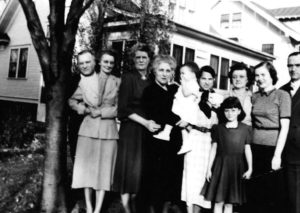
Sister Mary as a child (standing) with her family in 1950.
In 1966, Mary was encouraged to pursue her vocation by her good friend, Father Paul Mohrbacher. He told her, “the Benedictines have always been my favorite.” Right after this crucial conversation, she applied to St. Paul’s Priory at 301 Summit Avenue. Sister Marcelline Jung was the Prioress at that time. “Sister Marcelline knew that I was educated and already had my degree. It was easier to get in then.” Mary moved into the Priory’s carriage house at 301 Summit with thirteen other women. “I was a good rule keeper,” Mary recalls. “There were, of course, many rules. But I was at peace because I thought I was doing God’s will.”
Her class of postulants was the first to move into the new modern building of St. Paul’s Priory at 2675 Larpenteur Avenue. Mary loved living on the ground floor of the new Monastery. Sister Pat Collins was the Superior and Sister Rose Alice was the Novice Director. “I just went totally into it,” Mary said. “I said yes, I would try this. I didn’t balk at it at all. My family was very supportive. My dad continued to assure me that if I wasn’t happy, I would come home.” Mary is the only Sister from her class who remains in vowed religious life today.
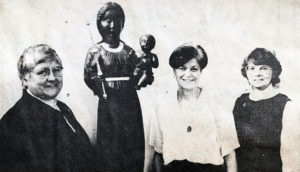
This picture was taken out of a newspaper in the 1980's when Sister Rosemary Rader (left), Sister Mary (middle) and Sister Virginia Matter (right) organized the Benedictine Center at St. Paul's Monastery.
Later, Mary returned to the University of Chicago and earned a second Master’s Degree in Religion and Psychological Studies. Her career plans included expanding her ability to assist people who were in “tough social situations” and bring this knowledge and experience back to the Monastery and the Community. Sister Mary received her counseling license in the mid-1980’s and practiced as a clinical social worker.
In the 1970’s, Mary worked for Catholic Charities, motivated by her strong concern for social justice. She worked for several years in child welfare with adoptions and assisting unwed parents. One of the highlights of her years there was when she attended a conference in Washington, D.C. on Paolo Friere’s Pedagogy of the Oppressed. “That really changed my life in terms of seeing how we need to be reciprocal in our relationships with people of all sociological and ethnic backgrounds. According to the liberation theologians, we are becoming more aware that we need to listen to the poor and understand their conditions. Just giving things to the poor is not enough.”
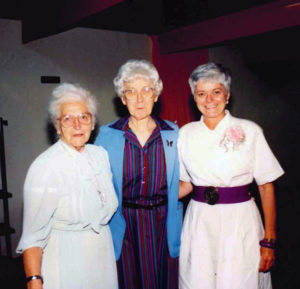
Sister Mary (left) at her 25th Jubilee with her mother, Louise (right), and Prioress Sister Rose Alice, OSB (middle).
Sister Mary was on the initial committee for the Twin Cities Religion and Justice Network (now CTUL) and continues to maintain her involvement with this organization. Centro de Trabajadores Unidos En La Lucha (CTUL) is a non-profit organization where workers organize, educate and empower each other to fight for a voice in their workplaces and in their communities. They identify the root causes of injustice and work to improve the lives of communities for present and future generations. Mary has been passionate about social justice causes all of her life, a value instilled in her by her mother, who taught her to pay attention and be compassionate toward others seen as different or excluded. She quickly points out that Jesus Christ himself sought the company of the outcasts, the poor, the oppressed— the people others avoided and shunned. In our Christian tradition, when we reach out to the poor and the sick and the homeless, Scripture tells us that we are ministering to Jesus himself and bringing about the Kingdom of God on earth: For I was hungry, and you gave me food; I was thirsty and you gave me drink; I was a stranger and you welcomed me…Whatever you did to one of the least of my brothers and sisters, you did to me (Matthew 25: 35-40).
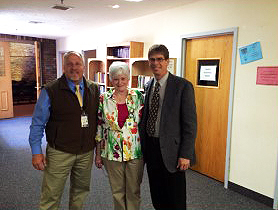
Mary White (middle) with Warden (left) and Chaplin (right) at Stillwater Prison in 1996.
“My mother really helped me to notice—even in the fourth grade—the kids who were not popular. She said, ‘Pay attention to the kids who are sitting alone.’ I’ve never forgotten that. I think my heart has always been with people who are socially or psychologically marginalized.” Mary realized that the way to help people is to focus on improving their lives economically: “I really wanted to do what I could to raise the level of their livelihood, especially for immigrants and the poor. As a Christian and as a Benedictine, I wanted to call attention to the wage level among Hispanics and other workers compared to ours. We still have a long way to go.”
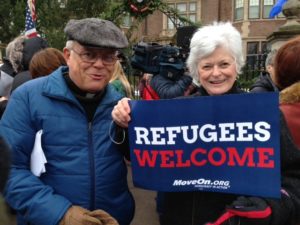
Father Greg Welch (left) and Mary White (right) rallying for refugees in 2016.
In the 1980’s, Sister Mary was the second director of the Benedictine Center for three years. She and other Sisters decided to create a satellite for the Benedictine Center in downtown St. Paul in the old Assumption School (next to Church of the Assumption). Mary’s mother purchased thirty “carefully selected” meditation chairs for the Center and helped to finish the room beautifully. Mary was director of the Meditation Center in the City for ten years, until 1993. The Center was very well received by the business community in downtown St. Paul. They received grant funding and many donations over the years, but it was not enough to keep the organization financially viable into the future. A number of people who frequented the Center in those years are now involved with Minnesota Contemplative Outreach and have carried on the meditation group tradition with lay persons ecumenically. After the Center in the city closed, Sister Mary continued doing counseling and spiritual direction. She has always believed very strongly in social outreach. “While meditating and quiet prayer are very important, we are also called by God to act according to what we are hearing in our prayer.” As Scripture tells us: Faith without works is dead. Mary then taught Centering Prayer to the inmates at the Stillwater State Prison and the Ramsey County Detention Center for a number of years and continued to work with groups such as Women Religious for Justice, CTUL, and the Trust for the Meditative Process.
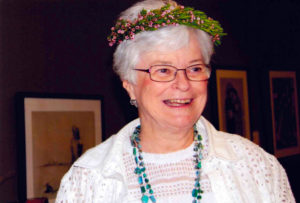
Sister Mary at her 50th Jubilee with a beautiful flower crown made for her.
While Mary loved living on her own in an apartment off-campus for a significant time, she moved home to the Monastery to be with the Community and assist the new Leadership team in 2019. “I had to give up some freedom. But I am very happy here. I have a strong interest in the stages of life and the scholarship around that. The ninth stage is the Gerontological stage of life (Eric Erikson, Psychologist, with wife, Joan, and Thomas Armstrong, PhD). We Sisters have a healthy attitude toward growing older and yet there is a culture among Sisters and other religious that we should continue working into our final age while some Sisters do so. I no longer believe that, because we know the special gifts of later years.” These years have a special “wisdom character” available following the generative stage of life. Mary hopes that we can all learn to nourish the spiritual side of ourselves as we get older, when we can finally stop being so busy and have more freedom to read and pray.
The Monastic Community of St. Paul’s Monastery has been greatly blessed by the many talents, vision and hard work of Sister Mary White throughout her an amazing career of over five decades. Mary plans to enjoy more quiet time now to be alone with God and at home with the Sisters. She will always be a champion for social justice and a great labor advocate. Looking to the future, Mary also hopes that the Benedictine Center, which she helped to found, will continue to have a presence in the Twin Cities. “It is very needed. Benedictine Spirituality is as popular now as it has been for 1500 years.”
